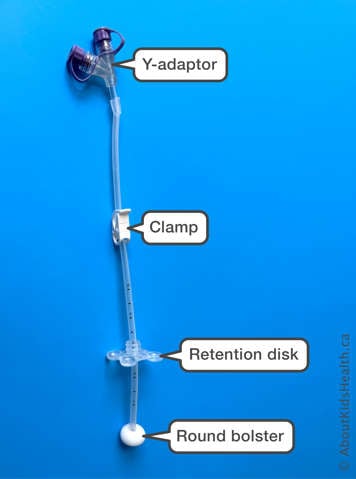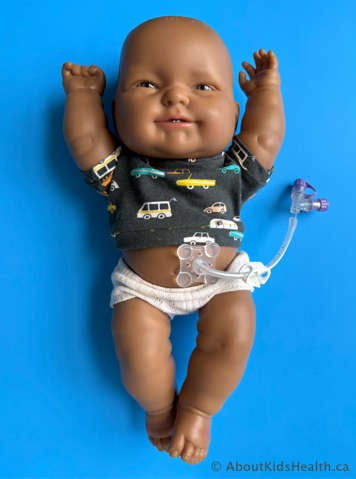
Gastrostomy tubes (G tubes) are feeding devices that provide liquid nutrition, medication, fluids or blended diet directly into the stomach. G tubes are placed through a surgical opening in your child's belly (abdomen) called a stoma. The tunnel from the outside into the stomach is called the tract. A MIC PEG tube is one type of G tube.
| The SickKids G-Tube Feeding Program has developed a one-page guide to help you quickly troubleshoot any issues with your child's feeding tube: G-Tube Feeding Program Family One Pager |

Inserting the MIC PEG tube
The MIC PEG tube is placed by an interventional radiologist using image guidance. There is a cone shaped bolster on the inside of the stomach that helps prevent the tube from being pulled out. A retention disk sits on the outside of the stomach and helps prevent the tube from moving into the stomach. The Y-adapter hangs at the end of the tube on the outside of the body.
Caring for the MIC PEG tube
After the insertion of a MIC PEG tube, your child's stoma will be left dry and open to the air. There is no need for a dressing. Occasionally, the interventional radiologist who placed the tube may apply a small gauze on the site, if they think it is necessary. If there is no leaking or discharge, the gauze can be removed.
Follow these instructions to care for your child's MIC PEG tube:
- Wash the stoma with soap and water daily, beginning 24 hours after the tube is inserted.
- Your child may begin to take baths 48 hours after primary tube insertion.
- It is recommended to secure the tube to the stomach with tape for the first few weeks. This is not a requirement; however, the weight of the tube can sometimes lead to stoma issues if it always sits in the same spot. Taping the tube and rotating where it is taped daily can help prevent this.
- For the first two weeks after insertion, do not adjust the retention disk. Contact your G tube specialist (at SickKids, this is the G Tube Resource Nurse) if you have concerns about the placement of the retention disk. For example, it might appear to sit too loose or too tight against your child's belly.
- After two weeks, the retention disk can be adjusted by you at home if it is too tight or too loose (see instructions below). If your child is still in hospital, a nurse can help you adjust the device.
- Your child may participate in their regular activities if they are feeling well and not experiencing severe pain or discomfort.
- Your child may go swimming two weeks after the tube insertion if the stoma has healed.
- For any tube or stoma issues, including infection, granulation tissue and leakage, call the G tube specialist.
How to adjust the retention disk
The retention disk should sit close to your child’s stoma, but it should not be too tight or too loose. Parents or caregivers can adjust the retention disk after the MIC PEG tube has been in place for more than two weeks.
To adjust the fit of the retention disk, gently slide the disk itself up or down the tube. Do not pull on the tube as this can lead to it being accidently pulled out of the tract and stoma.
MIC PEG Y-adaptor
The MIC PEG tube utilizes a Y-adaptor. This allows access for tube feeding, fluids, medication and blended diet administration. The Y-adaptor is attached to the end of your child's feeding tube and can be changed if needed (e.g., if the adaptor is broken).
Changing the MIC PEG Y-adaptor
To change your child's Y-adaptor, follow these instructions:
- Clamp the tube in order to prevent the stomach content from spilling out.
- Cut the tube directly under the Y adaptor.
- Clean the end of the tube.
- Insert a new Y-adaptor back into the tube.
How to change the clamp
- Clamp the tube to prevent the stomach content from spilling out.
- Cut the tube directly under the Y adaptor.
- Unclamp and remove the clamp from the tube.
- Clean the end of tube.
- Replace the clamp with a new one and clamp the tube closed.
- Insert a new Y-adaptor back into the tube.
What to do if your child's MIC PEG tube is accidentally pulled out
Although it is very unlikely, your child's MIC PEG tube may be accidentally pulled out. To learn what to do if your child's G tube is completely accidentally pulled out, please see the article What to do if your child's feeding tube is pulled out.
If the tube is only partially pulled out, the bolster on the end of the tube may become stuck in the tract. If this has happened, you may notice the following.
- significant pain in the G tube area
- a visible hard plastic bulge (the bolster) that does not go away when you move the tube
- you may be able to feel a hard bulge (the bolster) in the tract or stoma
- formula leaking from the stoma
If you are concerned that the tube has been partially pulled out and the bolster is stuck, call your G tube specialist right away. On the weekend/after hours, go to the Emergency Department.
Replacing the MIC PEG tube
To replace the dislodged, broken, or blocked tube, or to exchange it for a low-profile tube:
- Contact your child's G tube specialist to make an appointment for the tube replacement or exchange.
- A general anesthetic or sedation will be needed to remove a blocked or broken MIC PEG tube or to exchange to a low-profile tube.
- Your child's MIC PEG tube can be exchanged for a low-profile tube three months after the primary insertion date.
At SickKids
For SickKids patients, to replace a MIC PEG tube, an appointment must be made in the Image Guided Therapy (IGT) Department. Contact the G Tube Resource Nurse to schedule an appointment.
G Tube Resource Nurse contact info:
Phone 416-813-7177
g.tubenurse@sickkids.ca
On the weekend/afterhours, you may need to come to the Emergency Department for an alternate method of feed/fluids/medication administration.